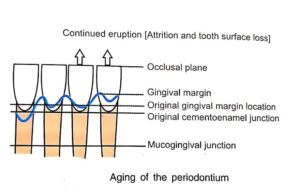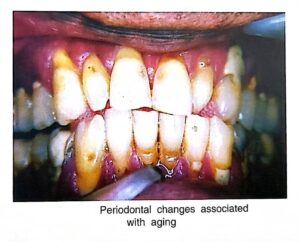Periodontal Structures in Aging Humans
GENERAL EFFECTS OF AGING
In the Skin
a. The dermis and epidermis are thinned
b. Keratinization is diminished
c. Blood supply is diminished
d. Degeneration of nerve endings occur
e. Capillaries appear to become more fragile which may
result in haemangiomas after minor traumas
f. Tissue elasticity is decreased.
Bone
a. Undergoes osteoporosis with aging
b. The bone is rarified, trabeculae are reduced in number and cortical plates are thinned
c. Vascularity is reduced and lacunar resorption is more prominent.
d. Increased susceptibility to fracture
e. With age water content of bone is reduced, the mineral crystals are increased in size and collagen fibers are thickened.

AGE CHANGES IN THE PERIODONTIUM
Gingiva/Gum and Other Areas of the Oral Mucosa
1. Decreased keratinization.
2. Reduced or unchanged amount of stippling.
3. Decreased connective tissue cellularity.
4. Decreased oxygen consumption-which may reflect
upon the metabolic activity.
5. Increased width of attached gingiva/gum.
6. Greater amounts of intercellular substances.
7. Atrophy of the connective tissue with loss of elasticity.
8. Increase in the number of mast cells.
Periodontal Ligament and Age Changes
In the Periodontium
1. Decrease in vascularity.
2. Decrease in mitotic activity.
3. Decrease in fibroblasts.
4. Collagen fibers and mucopolysaccharides are decreased.
5. Increase in elastic fibers and arteriosclerotic changes
are seen.
6. Both increase and decrease in the width of the periodontal ligament is seen. The periodontal ligament width is increased as a result of less number of teeth supporting the entire functional load and decrease in its width is associated with reduced strength of the masticatory musculature and continuous deposition of cementum and bone.
Changes in the Alveolar Bone and Cementum
1. Osteoporosis.
2. Decreased vascularity.
3. Reduction in metabolic rate and healing capacity,
4. Resorption activity is increased and the rate of bone formation is decreased.
5. Continuous deposition of cementum occurs with age and greater irregularity in the surface of both the cementum and alveolar bone facing the periodontal ligament is seen.
Bacterial Plaque and Immune Response
1. Plaque accumulation on teeth has been suggested to increase with age.
2. Some studies have shown a qualitative change in the subgingival flora, it has been speculated that a shift occurs in certain periodontal pathogens with age, including increase in number of enteric rods, Porphyromonas gingivalis and decreased role for Actinobacillus actinomycetemcomitans. Some-age related changes have been shown to affect the host response, but there is no evidence to show that these changes correlate with periodontitis in elderly patients.

EFFECTS OF AGING ON THE PROGRESSION OF PERIODONTAL DISEASES
The conclusions drawn from the various studies are strikingly-consistent and show that, age has either no effect or provides a small and clinically insignificant increased risk of loss of periodontal support. Therefore age has been suggested to be not a true risk factor but a background or an associated factor for periodontitis.
EFFECTS OF TREATMENT ON THE AGING INDIVIDUALS
The few studies that have been done so far have clearly demonstrated that inspite of certain changes in the periodontium with aging, no differences in response to nonsurgical or surgical treatment have been shown for periodontitis.